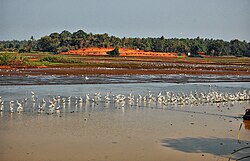Thrissur Kole Wetlands
| Thrissur Kole Wetlands | |
|---|---|

A view of Kole Wetlands with birds. A scene from Thomana in Thrissur Metropolitan Area
|
|
| Location | Thrissur District and Malappuram District, Kerala |
| Type | Freshwater |
| Primary inflows | Chalakudy River, Bharathappuzha River |
| Primary outflows | none |
| Basin countries | India |
| Surface area | 13,640 ha (33,700 acres) |
| Settlements | Thrissur |
| Designated | 2002 |
Thrissur Kole Wetlands (Malayalam: തൃശൂർ കോൾ പാടങ്ങൾ) is a unique wetlands lying in Thrissur District in Kerala, India. It gives 40 per cent of the Kerala’s rice requirement and acts as a natural drainage system for Thrissur city and Thrissur District. The Kole Wetlands is one of largest, highly productive and threatened wetlands in Kerala and has been declared in Ramsar Convention for protection and it comes in Central Asian Flyway of migratory birds.
From 18th century onwards, rice cultivation in Kole lands is said to have been started. But the Thrissur Kole lands recorded rice cultivation dates back to 1916 only.
The word Kole is a Malayalam word, and means that a bumper yield. It is a particular cultivation method adopted in wastelands in Thrissur District from December to May which otherwise is submerged from June to November, half of the year. The Kole wetlands lies between 10° 20' and 10° 40' N latitudes and 75° 58' and between 76° 11' E longitudes. The Kole wetlands are low lying tracts located 0.5 to 1m below Mean Sea Level (MSL) and remain submerges for about six months in a year. Kole lands in Thrissur are spread over eight blocks. The average annual rainfall is 3,200 mm and temperature varied from 28°C to 31°5°C.
The Kole Wetlands cover an area of about 13,632 hectares spread over Thrissur district and Malappuram district. The area extends from Chalakudy River in South to Bharathappuzha River in the North, and to Ponnani Taluk. The Kole Wetlands acts as natural drainage system for Thrissur city and Thrissur district through a network of canals and ponds which connects different parts of Kole Wastelands to river and then to the Arabian sea. It is fertile with Alluvium soil which is deposited Kechery and Karuvannoor river in the monsoon.
...
Wikipedia
